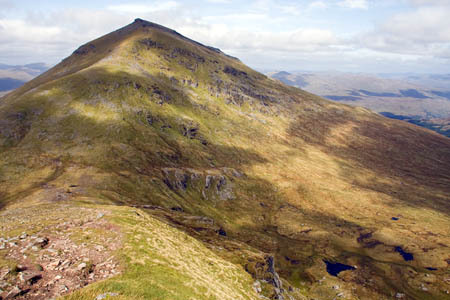A small group will gather on a Highland mountain tomorrow to mark the anniversary of one of the darkest days in British mountain rescue history.
Members of the Killin Mountain Rescue Team will make the trip to a memorial on the Perthshire corbett Ben Ledi to remember the night their team leader died when a search and rescue helicopter crashed.
Harry Lawrie died on 1 February 1987 near the 1,174m (3,85ft) summit of Ben More.
The story is recounted on his blog by David ‘Heavy’ Whalley, one of the elder statesmen of mountain rescue and himself a former leader of the RAF Leuchars Mountain Rescue Team.
An RAF Wessex helicopter piloted by Hugh Pierce and carrying the Killin leader Harry Lawrie, a police sergeant, clipped the mountainside of Ben More above Crianlarich with its rotor blade, bursting into flames and killing Sgt Lawrie and seriously injuring team-mate Ian Ramsay, another police officer, and the winchman Mick Anderson.
Eyewitness Sandy Chisholm told the Glasgow Herald at the time: “You could see the helicopter struggling to maintain its position.”
Members of the Killin MRT clambered into the smouldering wreckage and pulled out the casualties, treating them on the mountainside before an RAF Sea King helicopter from Lossiemouth flew in to evacuate them to Stirling Royal Infirmary
Chris Palgrave, who was one of the crew, suffered minor injuries.
The woman climber who the Killin team had gone to rescue was found dead the following day by the Killin team at the foot of a steep snow slope, a pair of new, unused crampons in her rucksack.
Heavy Whalley had been climbing on Ben Udlaidh with members of the RAF Leuchars Mountain Rescue Team and was driving between Tyndrum and Crianlarich when the Wessex flew over en route to Ben More.
“It was a wonderful winter’s night and we watched the helicopter as we drove down the road to Ben More. We saw a flash as the helicopter hit the mountain.
“It was surreal, like a film set, but it was real and we knew that a disaster had happened. The Wessex hit the hill and travelled about 1,000ft down the steep slope, just missing the Killin team who were searching.”
Mr Whalley said the Killin team acted with great professionalism, despite losing their leader, and said there were many heroes that night.
He added: “Killin is a team typical of mountain rescue, all who love the hills, made up of all types of people, the best there is.
“Even now 25 years after the crash the Killin team are a special bunch. They are incredible people, rarely in the news but what a team.
“This is what makes mountain rescue so special to me. I made many friends that night and the week ahead I was on the mountain with the Air Investigation Board, it was a really hard time.”
Mr Whalley, who is now retired from mountain rescue, said anyone heading for the hill should be aware of the risks. “It is worth remembering that if you go out on the mountains it is not risk free and never will be.
“The mountain rescue teams continue with the search and rescue helicopters to risk their lives to help others.
“Unfortunately sometimes accidents happen and always will. It is amazing that in these days of selfish bankers, politicians and greed that great people are still risking their lives to help others.
“Long may it continue; worth remembering?”

stuart counsell, glen maye, isle of man.
31 January 2012i echo every word you say. bankers and politicians couldn't
hold a candle against these fantastic teams. i am very proud of these men and women.